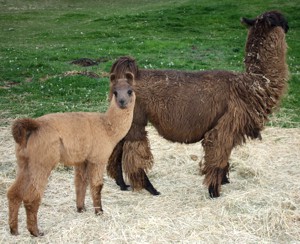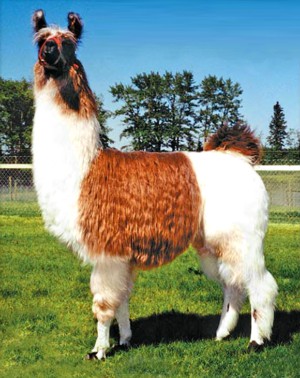About Llamas
Heritage

Llamas are members of the camel (camelid) family and were originally indigenous to North America. Ancient relatives migrated and evolved into today's camels and the four native members of the camel family in the Americas: the llama, one of the world's first domesticated animals and regarded throughout the world as the premier symbol of South American animals; the alpaca; the free ranging guanaco; and the wild vicuna.
The term lama (with one L) is used here to refer to all members of the camelid family, and the word llama is used to reference that particular species.
The camel family originated on the central plains of North America and spent their first 40 million years there before migrating to Asia and Africa some 3 million years ago to become today's camels. At the same time ancestors migrated to South America to become today's Lama family. Camelids became extinct in North America at the end of the last ice age approximately 10,000 to 12,000 years ago. The first llamas were domesticated in the Peruvian highlands some 4,000-5,000 years ago.
In the late 1800s and early 1900s private farms and zoos reintroduced them to their original North American homeland. Today there are an estimated 6,000 llamas in Canada.
Characteristics
Mature llamas weigh an average of 280-350 pounds but range between 250-500 pounds. Full growth is reached by the fourth year and while there is no obvious differences between the sexes, males tend to be slightly larger. They are long lived with a normal life span to 20 years.
Similar to cattle and sheep, llamas are multi-stomached (3) members of the order Tylopoda that chew cud. They have a hard upper gum (no upper teeth in front), grinding upper and lower molars in back, and an ingenious upper lip for grasping forage in unison with the lower incisors. Adult males develop large, sharp upper and lower canines (wolf teeth or fangs) for fighting. These "fighting teeth" should not be removed from llamas intended for sheep guards but should be removed to prevent injury to males pastured together or to females being bred.
The llamas' unique specially adapted foot makes them remarkably surefooted on a variety of terrain, including sandy soils and snow. It is two-toed with a broad leathery pad on the bottom and curved nails in the front. The small, oblong bare patches on the side of each rear leg are not essential toes (chesnuts as on horses) but metatarsal scent glands, suspected to be associated with the production of alarm pheromones. An additional scent gland is located between the toes.
Age can be determined reliably in young animals by checking the larger, permanent incisors that erupt to replace the "milk" front teeth. The middle pair comes in around between 2 and 2 ½ years of age and the second incisor at around 3 years of age.
Habits and Behaviour

Llamas have a very dignified aristocratic manner about them and are naturally curious, often coming close to sniff strangers. They prefer to be petted on their necks and backs and are a natural combination for working with children as they are gentle and rarely bite or kick unless provoked. They are highly social animals and need the companionship of another llama.
Llamas communicate their moods with a series of tail, body and ear postures, and vocalizations. Humming is a common manner of communicating between llamas and indicates a variety of moods from contentedness to concern. Another interesting llama vocalization is the shrill rhythmic alarm call emitted at the sight of a strange animal or a frightening situation.
Seldom directed at people, spitting is usually related to disputes over food and to establish a pecking order between llamas. If a llama has been mishandled, mistreated or become imprinted on people (through bottle feeding as a baby) the llama may have a tendency to spit at humans.
Bottle fed male llamas can be potentially dangerous when they reach adulthood as there is no longer the normal boundary between themselves and people. Bottle fed males must be gelded as early as possible to avoid undesirable behaviour.
Llamas are remarkably clean and even huge herds are quite ordourless. Dung piling behaviour is an important means of special orientation and territorial marking for these historically open habitat animals... a convenience when you clean their pens. Llamas can be encouraged to establish new dung piles by simply starting taking some llama "beans" and locating them in the desired spot.
Similar to horses you may frequently see your llama rolling in the dirt taking a dust bath to help maintain a healthy coat.
